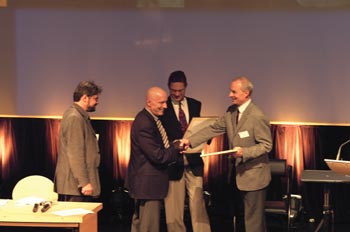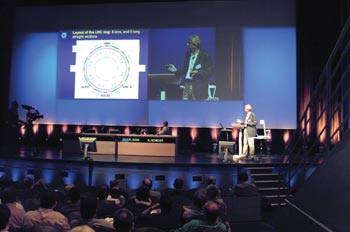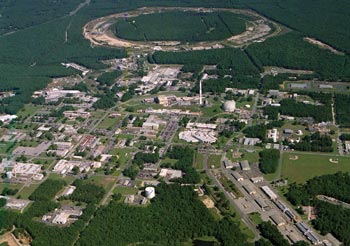This year’s European Particle Accelerator Conference, held in Paris, highlighted the growing diversity of particle accelerator technology. Francesco Ruggiero and Leonid Rivkin report.

The eighth European Particle Accelerator Conference (EPAC’02), held in Paris on 3-7 June, brought an unprecedented number of accelerator physicists and users together. With about 850 participants, including more than 150 from the US and nearly 60 students, and more than 1000 contributed or invited papers, this year’s gathering was the biggest EPAC to date. Representatives of the European Union and the high-energy physics community gave the opening and summary talks. Presentations ranged from beam dynamics to technology transfer and industrial spin-off, making the conference a remarkable international and interdisciplinary event.
Looking ahead
One of the highlights of the conference came from CERN, where the Compact Linear Collider (CLIC) study group has been investigating the use of materials other than copper for normally conducting accelerating structures. At the fields that would be needed to produce the high-accelerating gradients that the CLIC project aims to achieve, copper structures suffer severe surface damage. The CLIC team believes that this arises from field-emitted electrons that are accelerated from one side of the structure to the other, causing melting and erosion of the coupling irises (regions of smaller radius separating the cells of an accelerating structure). By replacing copper with tungsten irises, the CLIC team has succeeded in making structures able to withstand very high gradients for several thousands of hours without any surface damage.
CLIC’s novel two-beam acceleration scheme is a technology for the long-term future. Closer to the present is CERN’s Large Hadron Collider (LHC), and there were reports of activities at the laboratory’s existing accelerator complex to prepare for the new machine. Notable among these was a so-called beam-scrubbing run with LHC-type beam in the Super Proton Synchrotron (SPS), which will be the last link in the LHC injector chain. The idea of the scrubbing run, which took place in May, was to bombard the walls of the SPS vacuum chamber with electrons created by ionization of residual gas, accelerated by the beam, and multiplied by secondary emission (the electron cloud phenomenon). This had the effect of forcing outgassing and reducing the secondary electron yield, thereby improving the vacuum in the accelerator and allowing the SPS to achieve the beam intensities required for the LHC.
Returning to the present, there were reports outlining the excellent performance of the KEK-B and PEP-II B-factories in Japan and the US, as well as from the Italian Frascati laboratory’s DAPHNE accelerator, which supports the KLOE CP-violation experiment. Significant progress was reported from Brookhaven’s Relativistic Heavy Ion Collider (RHIC), where polarization levels of 40% have been maintained to top energy with proton beams.
Reports from Germany’s DESY laboratory and Fermilab in the US brought home the challenges of major luminosity upgrades. At DESY, background problems arising partly from back-scattering from masks behind the interaction points are limiting beam intensity, while at Fermilab’s Tevatron, growth of emittance (a measure of beam size times divergence) in the antiproton accumulator coupled with long-range beam-beam encounters are factors currently limiting the machine’s luminosity. Fermilab’s recycler ring, designed to retrieve, store and recycle antiprotons that would otherwise have been lost, is still in the commissioning phase. When it is fully operational, Tevatron luminosity is set to improve.
Light sources

Other news from DESY concerned the TESLA Test Facility (TTF), which has been established with the goal of providing a test bed for the TESLA linear collider concept and a free-electron laser. The TTF has achieved lasing down to a wavelength of 80 nm. This follows the announcement at last year’s particle accelerator conference (PAC) in Chicago that the low-energy undulator test line at Argonne National Laboratory’s advanced photon source had lased from the visible down to 130 nm. It marks a significant milestone on the road towards a free-electron laser in the hard X-ray region.
Other highlights from light sources include the first observations of steady state coherent synchrotron radiation in the far infrared at Berlin’s BESSY II synchrotron, and the successful commissioning of the Swiss Light Source (CERN Courier April p24). Emerging trends in this area are the growing number of free-electron laser projects, and many third-generation synchrotron sources under construction. Reports were given from Soleil in France, the Spanish synchrotron that will be built in Barcelona, and the UK’s Diamond machine.
Novel techniques
Several interesting new possibilities were reported from the Stanford Linear Accelerator Center (SLAC) in California, where work on bunch compression is under way at the laboratory’s 2 mile linac. This is motivated by the linear coherent light source proposal to build a 1-15 Å free-electron laser using linac beams of up to 15 GeV. The bunch compression work will allow the study of light emission in the so-called self-amplified spontaneous emission mode in a free-electron laser. It also opens up avenues for studies of plasma acceleration and wakefield studies, as well as the intriguing possibility of adding an “after-burner” to the linac. According to this idea, a dense plasma could double the energy of SLAC’s electron beams.
Fourth-generation light sources were a strong theme at the conference, with many proposed machine architectures being put forward. A light source for fast X-ray science proposed by Berkeley would be based on a recirculating linac and on dipole RF cavities plus gratings for photon pulse compression. Furthermore, short-pulse generation schemes based on energy recovery linacs, advanced by Cornell in particular, promise levels of performance well exceeding the present third generation of synchrotron light sources.
Induction accelerating devices (in which acceleration is achieved by changing the strength of a magnetic field in magnetic material encircling the beams) are being developed for high-intensity proton synchrotrons. Such devices could also create long super-bunches colliding with large crossing angles in future machines such as a very large hadron collider. They could also be used for a luminosity upgrade at the LHC.
Superconducting magnet developments based on the so-called wind-and-react technique for niobium-3 tin superconductor, or on new high critical temperature (Tc) materials were reported from Fermilab, Berkeley and Brookhaven. The wind-and-react technique overcomes the intrinsic brittleness of niobium-3 tin by winding the coil before inducing the reaction that forms the superconducting compound.
Beam dynamics

Among the hot topics presented in beam dynamics, several speakers reported new theoretical and experimental studies of the beam-beam interaction, including long-range encounters. These covered multiparticle simulations, wavelet approaches and observations at the B-factories. The associated reduction of dynamic aperture and the possible loss of collisionless (Landau) damping for coherent beam-beam modes may limit the performance of present and future hadron colliders. Compensation schemes based on non-linear lenses have been proposed and are being tested at Fermilab and at CERN. Electron cloud effects have been observed and are being intensively studied at the B-factories, at CERN accelerators and recently also at RHIC. Weak solenoids can successfully cure the problem in the field-free regions. Sophisticated simulation codes for electron cloud build-up and associated beam instabilities have been developed in several labs, and comparisons of predictions and observations were reported in many contributions.
The EPAC conferences, which cover all aspects of accelerator physics, technology and applications, are organized by the Interdivisional Group on Accelerators of the European Physical Society (EPS-IGA), an active group currently with about 200 members. The next conference, EPAC’04, will be held in Lucerne, Switzerland, on 5-9 July 2004. Next year’s major accelerator conference, PAC 2003, will be held on 12-16 May in Portland, Oregon, US.
Further reading
Selected papers will form a special issue of Physical Review Special Topics – Accelerators and Beams (PRST-AB). See http://prst-ab.aps.org/.





